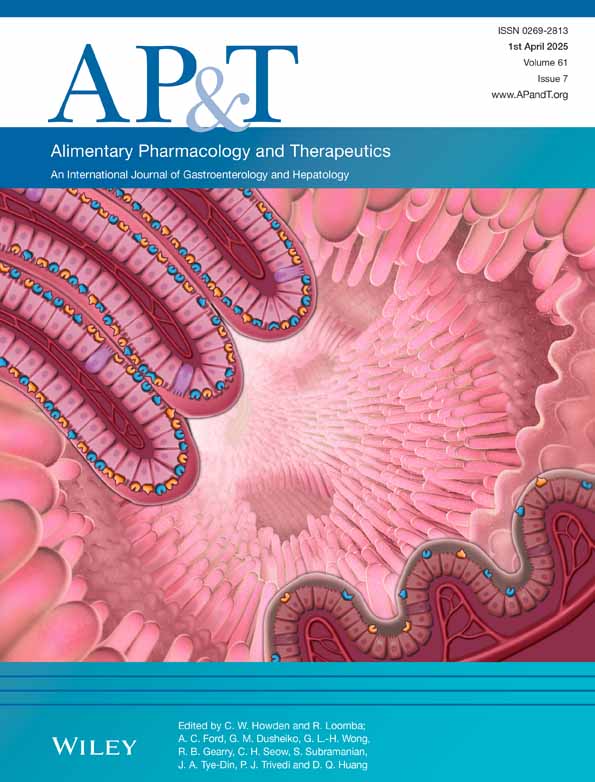Editorial: The Relevance of Hepatic Flares and Quantitative Hepatitis B Surface Antigen After Stopping HBV Polymerase Inhibitors—Authors' Reply
Funding: The authors received no specific funding for this work.
We sincerely appreciate Dr. Mauss's comments on our study recently published in the journal, [1] which examined the association between alanine transaminase (ALT) elevation and HBsAg seroclearance following cessation of nucleos(t)ide analogue (NA) therapy [2]. Because HBsAg seroclearance rarely occurs during NA therapy, treatment cessation without requiring HBsAg seroclearance has been proposed as an alternative strategy for managing chronic hepatitis B (CHB) [3]. Moreover, hepatitis flares that frequently follow NA cessation have been hypothesised to trigger immune responses conducive to functional cure [4, 5]. However, limited data exist regarding the relationship between hepatitis flare and HBsAg seroclearance. In our study, we employed multiple analytic approaches, including different methods to estimate the influences of retreatment on the incidences of HBsAg seroclearance, various thresholds for ALT elevation, and subgroup analyses stratified by cirrhosis status, to analyse a sizeable cohort. Our findings indicate that hepatitis flares are not associated with HBsAg seroclearance, suggesting that hepatocyte cytolysis is not essential to achieve a functional cure.
We agree with Dr. Mauss that our study was limited to an Asian cohort, where HBV genotypes B and C were predominant, [6] and a proportion (17%) of study participants were HBeAg-positive at treatment initiation. Therefore, caution is advised when extrapolating our findings to populations with different ethnicities, viral genotypes, or transmission modes. Nevertheless, our results address a critical knowledge gap in the decision-making regarding finite NA therapy and establish a foundation for future validation studies.
In this study, among 841 individuals who discontinued NA, 175 (20.81%) patients experienced hepatitis flare following NA cessation, four (0.48%) progressed to acute-on-chronic liver failure, and one (0.12%) subsequently died [2]. Similarly, our previous work pooled data from 15 studies involving 4525 individuals who stopped NA and reported a 1.21% rate of severe hepatitis flares or decompensation and a 0.37% rate of flare-related death or liver transplantation [7]. These findings highlight the potentially serious consequences of HBV reactivation following NA discontinuation. Hepatitis flares after NA cessation may be influenced by multiple factors, including viral, host, and treatment-related variables, and accurate risk prediction for severe flares is essential to ensure patient safety [8].
Since hepatitis flares are not associated with HBsAg seroclearance, the practice of finite NA therapy should focus on identification of patients at low risks of withdrawal flares. In this context, serum levels of HBsAg and hepatitis B core-related antigen (HBcrAg) have emerged as valuable biomarkers for risk prediction. Lower HBsAg and HBcrAg levels at treatment cessation typically indicate a lower risk of hepatitis flares [9, 10].
In the current study, we reaffirmed that an HBsAg level of 100 IU/mL could serve as a practical cutoff to distinguish Asian patients at distinct risks of hepatitis flares following NA withdrawal [2].
In summary, ALT elevation is not associated with HBsAg seroclearance in CHB patients who discontinue NA therapy. Consequently, treatment cessation is not advisable for patients at high risks of ALT flares due to potentially serious consequences. Effective risk stratification before NA cessation is therefore crucial to identify those patients who are more likely to achieve HBsAg seroclearance safely.
Author Contributions
Ying-Nan Tsai: writing – original draft, conceptualization. Jia-Ling Wu: software, data curation. Yao-Chun Hsu: writing – review and editing, supervision.
Acknowledgements
The authors declarations of personal and financial interests are unchanged from those in the original article [2].
Conflicts of Interest
Ying-Nan Tsai and Jia-Ling Wu reported no conflicts of interest. Yao-Chun Hsu has received research grants from Gilead Sciences, lecture fees from Abbvie, Bristol-Myers Squibb, Gilead Sciences, Grifols, and Roche, and has served as an advisory committee member for Gilead Sciences and Sysmex.
Linked Content
This article is linked to Tsai et al. papers. To view these articles, visit https://doi.org/10.1111/apt.18515 and https://doi.org/10.1111/apt.70009.
Open Research
Data Availability Statement
The authors has nothing to report.




